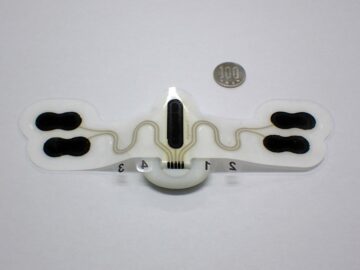For many years now, transistors on our microchips have gotten smaller, faster, and cheaper over time. Every two years, the number of transistors on commercial chips has doubled — with this phenomenon becoming widely known as “Moore’s Law.” For several years in the recent past, Moore’s Law does not seem to hold true any longer. Miniaturization of chip sets has reached a natural limit, and new problems begin to arise as a length scale of only a few nanometers is approached.
The next big step in miniaturization may become possible using so-called “two-dimensional (2-D) materials” that consist of only a single atomic layer. With help from a new insulator made from calcium fluoride, scientists at TU Wien (in Vienna, Austria) have created an ultra-thin transistor, which has excellent electrical properties and, in contrast to legacy technologies, can be miniaturized to an even smaller size than previously possible. The new technology was recently presented in the journal Nature Electronics.
Ultra-Thin Semiconductors and Insulators
Research surrounding semiconductor materials required to fabricate transistors has shown significant progress in recent years. Ultra-thin semiconductors can now be made from 2-D materials, which consist of just a few atomic layers. “But this is not enough to build an extremely small transistor,” according to Professor Tibor Grasser of the Institute of Microelectronics at TU Wien. “In addition to the ultra-thin semiconductor, we also need an ultra-thin insulator.” This is a result of the fundamental structure of a transistor: the current is able to flow from one side of the transistor to the other, but only as voltage is applied to the middle, which is what creates the electric field. The electrode that provides this field must be electrically insulated from the semiconductor itself.
“There have already been transistor experiments with ultra-thin semiconductors, but until now, they were coupled with ordinary insulators,” said Professor Grasser. “There’s not much benefit in reducing the thickness of the semiconductor when it still has to be combined with a thick layer of insulator material. There’s no way of miniaturizing such a transistor any further. Also, at very small length scales the insulator surface turned out to disturb the electronic properties of the semiconductor.”
Yury Illarionov, from Professor Grasser’s team, then tried a novel approach. The researcher incorporated ultra-thin 2-D-materials, not only for the semiconductor part of the transistor, but also for the insulation mechanism. By selecting ultra-thin insulating materials like ionic crystals, the transistor of only a few nanometers size is able to be constructed. The electronic properties are improved because the ionic crystals have a perfectly regular surface, without a single atom protruding from the surface, which might disturb the electric field. “Conventional materials have covalent bonds in the third dimension — atoms that couple to the neighboring materials above and below,” explained Professor Grasser. “This is not the case in 2-D materials and ionic crystals, and so they do not interfere with the electrical properties of the semiconductor.”
The Prototype is a World Champion
To produce the new ultra-thin transistor, calcium fluoride was chosen as the primary insulating material. A calcium fluoride layer was also produced at the Ioffe Institute in St. Petersburg, where the author of the publication, Yury Illarionov, is originally from. The transistor itself was manufactured by Professor Thomas Müller’s team at the Institute of Photonics at TU Wien, and later analyzed by a team at the Institute for Microelectronics.
The first prototype surpassed all of their expectations. “For years, we have received quite a number of different transistors to investigate their technical properties — but we have never seen anything like our transistor with the calcium fluoride insulator,” said Professor Grasser. “The prototype with its superior electrical properties outshines all previous models.”
Following their success, the team now wants to find out which combinations of insulators and semiconductors will work together for the best results. It may still be a few more years before the technology is able to be used for commercially available computer chips because the manufacturing processes for the material layers still has to be optimized.
“In general, however, there is no doubt that transistors made of 2-D materials are a highly interesting option for the future,” says Tibor Grasser. “From a scientific point of view, it is clear that the fluorides we have just tested are currently the best solution for the insulator problem. Now, only a few technical questions remain to be answered.”
This new type of smaller and faster transistor should enable the computer industry to take the next big step. This way, Moore’s law of exponentially increasing computer power may soon return to relevance.
- SEO Powered Content & PR Distribution. Get Amplified Today.
- PlatoData.Network Vertical Generative Ai. Empower Yourself. Access Here.
- PlatoAiStream. Web3 Intelligence. Knowledge Amplified. Access Here.
- PlatoESG. Carbon, CleanTech, Energy, Environment, Solar, Waste Management. Access Here.
- PlatoHealth. Biotech and Clinical Trials Intelligence. Access Here.
- Source: https://www.microsi.com/blog/ultra-thin-transistors-enable-faster-computer-chips/?utm_source=rss&utm_medium=rss&utm_campaign=ultra-thin-transistors-enable-faster-computer-chips
- :has
- :is
- :not
- :where
- a
- Able
- above
- According
- addition
- All
- already
- also
- an
- analyzed
- and
- any
- anything
- applied
- approach
- ARE
- arise
- AS
- At
- atom
- atomic
- Austria
- author
- available
- BE
- because
- become
- becoming
- been
- before
- begin
- below
- benefit
- BEST
- Big
- Bonds
- build
- but
- by
- CAN
- case
- cheaper
- chip
- Chips
- chosen
- clear
- combinations
- combined
- commercial
- commercially
- computer
- computer power
- contrast
- Couple
- coupled
- COVALENT
- created
- creates
- Current
- Currently
- different
- Dimension
- do
- does
- doubled
- doubt
- Electric
- Electronic
- enable
- enough
- Even
- Every
- excellent
- expectations
- experiments
- explained
- exponentially
- extremely
- faster
- few
- field
- Find
- First
- flow
- For
- from
- fundamental
- further
- future
- General
- Have
- help
- highly
- hold
- However
- HTTPS
- improved
- in
- Incorporated
- increasing
- industry
- Institute
- interesting
- interfere
- investigate
- Ionic
- IT
- ITS
- itself
- journal
- just
- known
- later
- Law
- layer
- layers
- Legacy
- Length
- like
- LIMIT
- longer
- made
- manufactured
- manufacturing
- many
- material
- materials
- May..
- mechanism
- Middle
- might
- models
- more
- much
- must
- Natural
- Nature
- Need
- neighboring
- never
- New
- next
- no
- novel
- now
- number
- of
- on
- ONE
- only
- optimized
- Option
- ordinary
- originally
- Other
- our
- out
- over
- part
- past
- perfectly
- PETERSBURG
- phenomenon
- plato
- Plato Data Intelligence
- PlatoData
- Point
- Point of View
- possible
- power
- presented
- previous
- previously
- primary
- Problem
- problems
- processes
- produce
- Produced
- Professor
- Progress
- properties
- prototype
- provides
- Publication
- Questions
- quite
- reached
- received
- recent
- recently
- reducing
- regular
- relevance
- remain
- required
- researcher
- result
- Results
- return
- Said
- says
- Scale
- scales
- scientific
- scientists
- seem
- seen
- selecting
- semiconductor
- Semiconductors
- Sets
- several
- should
- shown
- side
- significant
- single
- Size
- small
- smaller
- So
- solution
- Soon
- St. Petersburg
- Step
- Still
- structure
- success
- such
- superior
- Surface
- surpassed
- Surrounding
- Take
- team
- Technical
- Technologies
- Technology
- tested
- than
- that
- The
- The Future
- their
- then
- There.
- they
- Third
- this
- time
- to
- together
- tried
- true
- Turned
- two
- type
- until
- used
- using
- very
- View
- Voltage
- wants
- was
- Way..
- we
- were
- What
- when
- which
- widely
- will
- with
- without
- Work
- work together
- world
- years
- zephyrnet


